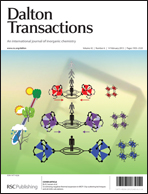The molecular and electronic structures, stabilities, bonding features, magnetotropic and spectroscopic properties of the triangular Pt3(μ2-L)3(L′)3 clusters and their [(μ3-Tl)Pt3(μ2-L)3(L′)3]+ (L = CO, SnR2, SnH2, SiR2, SiH2, CH3CN, PH2, C6F5, SO2 or HCN and L′ = CO, PH3, CH3CN, C6F5, HCN) half-sandwiches have been studied by means of density functional theory (DFT) calculations. It is found that the optimized Pt–Pt intermetallic distances in the clusters are well below the sum of the van der Waals radii of the two Pt metal atoms (3.44 Å). The triangular Pt3(μ2-L)3(L′)3 clusters trap a thallium(I) cation forming stable “open face” half-sandwiches. The distance between Tl(I) and the centroids of the Pt3 rings in the half-sandwiches is calculated to be within the range 2.52–2.86 Å. Energy decomposition analysis (EDA) calculations using a dispersion corrected B3LYP-D functional reveal that the interaction of Tl(I) with the Pt3 ring in the half-sandwiches is dominated by the interplay of electrostatic and orbital interactions with a small contribution from dispersion forces as well. In addition, charge decomposition analysis (CDA) calculations indicate strong donor–acceptor interactions between Tl(I) and the rings. The estimated proton affinities (PAs) of the triangular Pt3(μ2-L)3(L′)3 clusters illustrate their relatively strong π-basic character. Furthermore, an excellent linear relationship between the PAs of the Pt3(μ2-L)3(L′)3 clusters and the bond dissociation energies (D0) of the [(μ3-Tl)Pt3(μ2-L)3(L′)3]+ half-sandwiches was established. The magnetotropicity of these systems was studied by calculating the NICSzz-scan profiles. The spectroscopic properties of the triangular Pt3 clusters and their TlPt3 half-sandwiches were studied by means of TDDFT calculations. The simulated absorption spectra are dominated by strong absorption bands in the UV region. The emission band maxima of the triangular Pt3 clusters are predicted to lie within the IR region. In order to gain insight into the phosphorescence process of these systems, we have optimized their first triplet excited state, T1. The estimated deep HOMO energy for these compounds makes them promising candidates for use as “hole” blocking materials in LED devices. Also, it is expected to exhibit small non-radiative decay rate constants due to their relatively large S0–T1 energy difference making them suitable PHOLED emitters or dopants in organic polymer matrices constituting the recombination layer of an OLED device.


 Please wait while we load your content...
Please wait while we load your content...